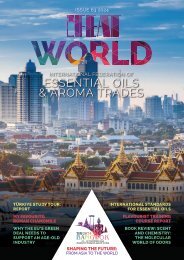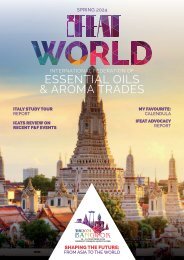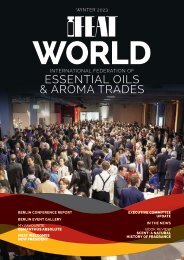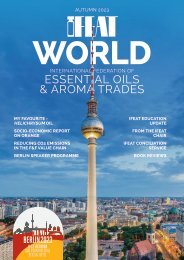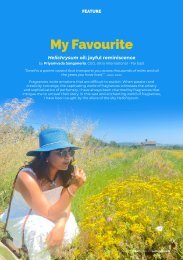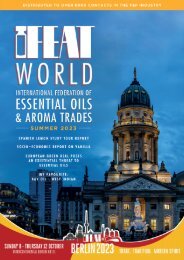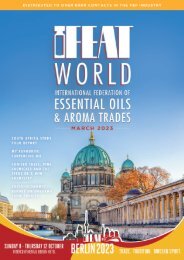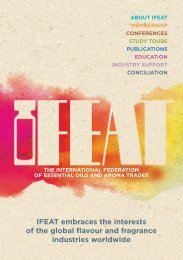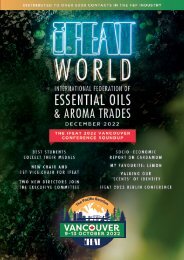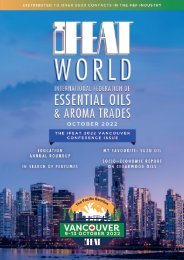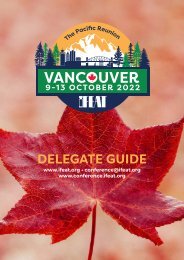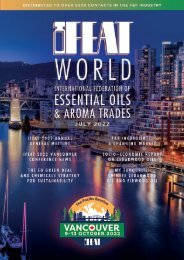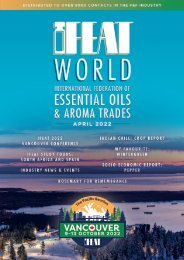IFEATWORLD April 2021
IFEATWORLD April 2021. News from the aroma trades industry.
IFEATWORLD April 2021. News from the aroma trades industry.
Create successful ePaper yourself
Turn your PDF publications into a flip-book with our unique Google optimized e-Paper software.
Transforming Brazilian
aromatic plants into amazing
fragrance ingredients
C O P A I B A
SUPPORTING THE STANDING FOREST,
CREATING OPPORTUNITIES AND PROMOTING SUSTAINABILITY
To learn more about Copaiba, scan the QR Code
WORLD 3
WELCOME TO THE
FIRST 2021 EDITION
OF IFEATWORLD
IFEAT’s first Virtual Conference (VC)
was deemed a success! Over 500
people registered and between
them held thousands of meetings
on the platform from registration
opening on 17th November 2020
until the event closed on 14th March
2021. The plenary sessions proved
to be extremely popular too with
some having in excess of 300 views,
both as they were streamed live
and later when people watched
them on demand. You can read the
report on pages 6-8. A full report
on the Virtual Conference speaker
programme will be available on the
IFEAT website soon.
Also in this issue, we bring you
the latest Socio-Economic Report
which looks at nutmeg. We have
our regular feature “My Favourite”
and for this issue we invited IFEAT
Member, Rithika Gupta, to talk
about Indian sandalwood. If you
would like us to consider publishing
an article on your favourite
essential oil, please email Tina
Hotchin, IFEATWORLD Editor, on:
ifeatworld@ifeat.org
We take a brief look at UK REACH
after BREXIT and what this means
and we have information on the
2020 Labelling Manual by the
IFRA-IOFI GHS Task Force as well as
details of the RIFM Concentration
Survey 030.
IFEAT is calling for experienced
industry individuals who would like
to apply to join the IFEAT Panel of
Experts. More information about
this can be found on page 5.
IFEATWORLD is now printed by a
CarbonNeutral ® print company. This
forms part of the new sustainability
initiative currently being developed
by IFEAT.
“I hope you enjoy this edition of
IFEATWORLD. Please email me if you
would like to contribute an article.”
Tina Hotchin
Editor
4
NEW CarbonNeutral ® SUPPLIER FOR IFEATWORLD
WORLD
NEW CarbonNeutral ®
SUPPLIER FOR
IFEATWORLD
IFEAT’s quarterly newsletter is now
printed by the Pureprint Group on
sustainably sourced paper certified
by FSC ® and Carbon Balanced with
the World Land Trust.
Pureprint has a long list of
environmental awards and in
2002 they became the first
CarbonNeutral ® printer in the
world. A CarbonNeutral ® Company
measures its carbon footprint and
then invests in carbon reduction
Along with a series of other sustainability initiatives IFEAT is implementing,
we have a new CarbonNeutral ® supplier producing IFEATWORLD
projects to compensate for its own
emissions so that its carbon impact is
net zero.
For example, they have recently
invested in a Kenyan Cookstoves
project and a Household Agricultural
Biogas project in Vietnam helping to
create a clean and affordable energy
supply for 800,000 people. Since
2002 the company has offset more
than 28,000 tCO2e – equivalent to
over 110 million economy flight miles.
In 2003 they were the first printer
in the UK to receive the Queen’s
Award for Enterprise: Sustainable
Development and received the
award again in 2008 and 2013.
Pureprint is now not only our
supplier for IFEATWORLD but
they also advise us on sustainable
printing and paper purchasing.
WORLD 5
DOMINIQUE ROQUES RELEASES NEW BOOK
CUEILLEUR D’ESSENCES
Dominique Roques, Chairman of the
IFEAT Communications Committee,
has released a book.
The book, “Cueilleur d’essences”, is
written in French, was published in
March 2021 and will be available in
six languages.
From the farmers of Bangladesh
who drive nails into trees to
accelerate the formation of
oud wood to the harvesters of
Salvadorian balsam, hanging from
the branches in the void with a
burning torch in their hand, each
chapter takes the reader on a
fragrant journey around the world in
search of the rarest essential oils.
“We learn that in 1840, more than
a century after the importation of
vanilla into Europe, it is an 11-yearold
boy who finally understands
the principle of pollination and
makes it bear fruit. We discover the
enfleurage technique, patchouli’s
bumpy history, the kidnapping of
the Amazonian rubber tree by the
English at the beginning of the 20th
century, the murders committed in
India for sandalwood and the
replanting of entire fields at the
bottom of Australia, in the
incredible region of pink
diamonds… And a thousand other
anecdotes that weave the
extraordinary kaleidoscope of the
scents of the world.”
Cueilleur d’essences is being
translated into English, Dutch,
Spanish, Italian, Russian and Chinese
(two editions: China and Taiwan).
For more information visit:
www.grasset.fr/livres/
cueilleurdessences-9782246826231
DOMINIQUE ROQUES RELEASES NEW BOOK
IFEAT PANEL
OF EXPERTS
A UNIQUE WORLDWIDE GROUP OF EXPERTS ACTIVE
ON SCIENTIFIC & SOCIO-ECONOMIC MATTERS
IFEAT has a large reach in terms
of people and activities related to
the world of flavour and fragrance
ingredients - in particular ingredients
derived from nature.
Alongside the Executive Committee,
IFEAT is building a unique and vast
network of pro bono experts. These
individuals have spent most of their
lives working in specific disciplines
related to the vast world of natural
derivatives - such as natural extracts
and essential oils, or chemical
fractions and their derivatives. Each
expert also has a minimum of 30
years’ experience in the F&F industry.
IFEAT is about passion, commitment
and results, and regularly engages
its team of international experts
to accomplish projects that are
beneficial to our industry.
If you have a profound attachment
with our industry, along with many
years of expertise, and the desire
to work on a pro bono basis with a
team of like-minded experts from
IFEAT, then we welcome you to
contact us for further discussion.
Hopefully you will meet the
necessary criteria to join our select
IFEAT Panel of Experts. IFEAT
will screen all candidates, and
define a timeline to join the IFEAT
Panel of Experts, according to
requirements.
For more information, please
contact:
scientific.enquiries@ifeat.org
IFEAT PANEL OF EXPERTS
6
WORLD
IFEAT’S FIRST
VIRTUAL
CONFERENCE
TUESDAY 19TH TO THURSDAY 21ST JANUARY 2021
IFEAT’S FIRST VIRTUAL CONFERENCE
Conferences have taken pride of
place in IFEAT activities and are
a vital component of its annual
operations. A sizeable proportion of
IFEAT’s administrative activities are
spent on conference planning and
organisation, and as conferences
have grown both in the number
of participants and in the range of
activities offered, so their complexity
has increased. Prior to 2020, the last
time an annual IFEAT Conference
was unable to be held was almost 40
years ago when the planned Cairo
Conference was cancelled in 1981
following the assassination a few days
earlier of the Egyptian president. In
later years political and economic
instability have created uncertainties
about holding conferences in Tel Aviv,
Jakarta, Buenos Aires and Montreal
but solutions were found, often at
very short notice, and the annual
conferences went ahead.
The COVID-19 pandemic of 2020
led to the postponement of the
Berlin Conference in October 2020
and global travel and quarantine
restrictions ruled out the possibility
of holding a physical conference at
another location. Determined that the
“show must go on’’ IFEAT decided to
organise its first Virtual Conference
(VC) from 19th to 21st January 2021.
The title of Keeping the Industry
Together, reflected IFEAT’s unique
achievement over the past 40 years
of organising annual conferences that
brought together all the stakeholders
in the F&F industry.
IFEAT’s VC Committee and a small
IFEAT staff team faced a very short
time frame and a very steep learning
curve on how to organise its first
VC. Unlike a physical conference,
organising a VC does not necessitate
decisions on a location, venue, hotels,
catering, entertainment or field trips.
However, it does require key decisions
on the selection of dates and times,
and most importantly the choice of
a suitable platform and partner to
meet the diverse needs of an IFEAT
Conference. This includes organising
a programme of presentations and
panel discussions over a three-day
period, while trying to meet the needs
of delegates operating in a wide
range of time zones, the selection of
suitable networking opportunities and
facilities, recruiting presenters and
session chairs as well as attracting
sponsors and the promotion and
marketing of the VC.
Given the considerable constraints
faced, the VC was recognised
as being very successful, and
going forward the experience and
knowledge acquired will be beneficial
in organising future IFEAT events. For
example:
• It creates the potential for future
“hybrid” IFEAT events, in which both
actual and virtual events are
combined, thus enabling greater
participation of people from the
F&F sector in IFEAT’s increasingly
PANEL DISCUSSION
Aromatherapy: Science and Safety
WORLD 7
CROP REPORT ON CITRUS
By Sergio Davalos and Colin Ringleib
diverse activities. The VC attracted
new participants, both IFEAT
members and non-members,
who for various reasons (e.g. cost,
logistics, travel restrictions) might
have been unable to participate in
the actual conference but were
able to participate in a VC.
• Another very successful VC
initiative was the detailed crop
reports presented on each of the
three days. These dealt with three
of the largest groups of F&F
ingredients, namely mint, citrus and
spices. Going forward, crop reports
could become a feature of IFEAT
Conferences.
• Until 14th March 2021 all delegates
were able to watch the recordings
of the live presentations and panel
discussions as well as previous
conference presentations. This
proved to be another successful
initiative that could be carried
forward to future IFEAT events.
• Companies were able to hold their
own webinars and make
presentations to all the delegates
– again, another possible initiative
for future conferences.
• Despite the lower number of
delegates at the VC than at recent
IFEAT Conferences, the audience
levels at the live presentations and
panel discussions were higher than
at an actual conference. In part this
is because networking and seeing
clients and making new contacts
is the major raison d’être behind
conference attendance.
What did VC delegates receive for
their relatively small booking fee?
• There were 14 video presentations
of speakers from the past three
conferences in Athens 2017,
Cartagena 2018 and Bali 2019
available to watch on demand
throughout and after the live event.
• Participation in a whole series of
presentations, panel discussions
and crop reports each with their
own Q/A sessions over a threeday
period. In all there were 33
presentations and three extremely
informative panel discussions on:
• Business & Naturals: 2020 and
2021 Trends & Challenges
• Regulatory and Scientific Issues
• Aromatherapy: Science and
Safety
• Networking with over 500
registered delegates.
• The opportunity to visit over 100
“virtual booths” that companies
and individuals had established
to facilitate their networking
opportunities.
The sponsoring companies and
“virtual booth” holders, besides
IFEAT’S FIRST VIRTUAL CONFERENCE
PANEL DISCUSSION
Business & Naturals: 2020 and 2021 Trends & Challenges
8
WORLD
THE F&F INDUSTRY IN A COVID WORLD
Presented by Michael Carlos, moderated by Dominique Roques
IFEAT’S FIRST VIRTUAL CONFERENCE
holding private meetings, were
able to hold their own webinars, as
well as disseminate videos and a
range of other material about their
operations and products. While
“virtual booths” went some way
towards facilitating meetings and
networking they were unable to
fully re-create an actual conference
networking experience, in part
because of the inability to smell and
taste products.
Many of the Virtual Conference
presentations and panel discussions
analysed both the negative and
positive impacts of the COVID-19
pandemic on the F&F and
aromatherapy sectors as well as the
global economy. Some sectors were
badly affected (e.g. fine fragrances
and food services) while others
have benefitted considerably (e.g.
aromatherapy and products with
antiseptic and medicinal qualities).
During the past year the F&F and
related sectors have shown the
ability to adapt and innovate in the
face of considerable adversity.
GOLD SPONSORS
There is no doubt that the world of
essential oils and F&F will witness
further transformational changes in
the decades ahead. In organising
a successful VC at short notice,
IFEAT has shown its ability to
adapt quickly to a rapidly changing
environment both globally and
locally – and this bodes well for the
continued success of IFEAT in an
ever-changing world. Nevertheless,
we are all looking forward to
meeting up again face to face at an
actual IFEAT Conference!
SILVER SPONSORS
10
UK REACH AFTER BREXIT - WHAT THIS MEANS
WORLD
If your company is based in England,
Scotland or Wales, EU REACH
(Registration, Evaluation, Authorisation
and Restriction of Chemicals) no
longer applies now that the UK has
left the EU.
The UK Government has implemented
its own version known as “UK REACH”.
This came into force on 1st January
2021. Northern Ireland is still covered
by EU REACH according to the IE/NI
Protocol (the Protocol on Ireland and
Northern Ireland).
Companies that are supplying and
purchasing substances, mixtures or
articles to and from the EU/EEA/
Northern Ireland and Great Britain
(England, Scotland and Wales) will
need to ensure that the relevant
duties are met under both pieces of
legislation (Health & Safety Executive).
Registration with UK REACH after
Brexit is very similar to registration
with EU REACH and UK REACH
regulations have to be followed
whether you manufacture, import, sell
UK REACH
AFTER BREXIT
WHAT THIS MEANS
or distribute chemical substances or
mixtures. So, for example, if you are
a UK-based storage facility handling
chemicals that go to or come from EU
countries, the products themselves
may have to comply with both the
UK and EU REACH regulations. It is
the responsibility of the individual
company to assess its operations and
decide whether compliance with both
of these regulations is a requirement.
The UK REACH regime replicates the
EU system as closely as possible,
maintaining the fundamental aims
and purposes of REACH including
high standards of health and
environmental protection.
THE AIMS OF UK
REACH INCLUDE:
• To provide a high level of protection
of human health and the
environment from the use of
chemicals.
• To make the people who
place chemicals on the market
(manufacturers and importers)
responsible for understanding and
managing the risks associated with
their use.
• To promote the use of alternative
methods for the assessment of the
hazardous properties of substances
e.g. quantitative structure-activity
relationships (QSAR) and read
across (Health & Safety Executive).
For more information, please visit:
www.hse.gov.uk/reach/
whatisreach.htm
www.gov.uk/guidance/how-tocomply-with-reach-chemicalregulations
If you have any questions please
contact: scientific.enquiries@ifeat.org
REFERENCE
Health & Safety Executive, n.d.,
What is UK REACH?, Health & Safety
Executive, viewed 19th February
2021, www.hse.gov.uk/reach/
whatisreach.htm
ESSENTIAL OILS’ IDENTITY CRISIS
In the March 2021 issue of Perfumer
& Flavorist magazine, you can read
an article by IFEAT President Alastair
Hitchen and Dr Wladyslaw S Brud
(Co-option to the IFEAT EC).
“Proper identification of essential oils
ESSENTIAL OILS’
IDENTITY CRISIS:
HOW DATA PROBLEMS CAN CREATE
CHALLENGES FOR INDUSTRY
remains a challenge even as demand
for natural ingredients, particularly
essential oils, continues to grow.
Therefore, the relationship between
industry factors and research on
essential oils are the subject of this
article.”
To read the full feature article,
please visit:
www.perfumerflavorist.com/
fragrance/rawmaterials/
natural/Essential-Oils-Identity-
Crisis-573768721.html
WORLD 11
OBITUARIES
PAUL AHN
Paul Ahn, founder and President of
Flavor Materials International, passed
away on 8th February 2021. He was
69 years old.
Born and raised in New Jersey, Paul
founded FMI in 1984. He grew the
business from a small local operation
to a multinational company with
footprints in the United States, Asia,
and Central America. Paul loved this
industry and poured his heart and
soul into making Flavor Materials
International the company that it is
today.
Paul left a lasting impression on
everyone he met. He will be widely
remembered for his creativity,
entrepreneurial spirit and enduring
personal relationships throughout
the industry. Paul will be greatly
missed, but his legacy and vision will
live on through the FMI team.
KARL
POEHLMANN
OBITUARIES
Karl Poehlmann, Chairman of
George Uhe Co., Inc, passed
away due to complications from
COVID-19 in 2020. He was 86 years
old. Karl had served his friends
and colleagues in the flavour and
fragrance industry for over 60 years.
After emigrating from Germany to
the United States in 1958 to attend
graduate school at the University
of Michigan, Karl was hired by
George Uhe in 1959 as a broker and
trader in the company’s essential
oils and agricultural commodities
department. He would eventually
head that department and then go
on to buy the company from the Uhe
family in 1988.
Over the course of his long career,
he worked to introduce numerous
new essential oil products and
producers to the market and help to
commercialise major new product
sectors and technologies such as
citrus juice by-products and spice
oleoresins.
Karl truly loved working in this
unique industry. He was dedicated
to making his own contributions to
its growth and success, and over
the years Karl volunteered his time
in many industry associations.
The George Uhe Company was
one of the founding members of
IFEAT. Karl served for many years
on the Executive Committee and
was Chairman of the Finance
Committee from 2003 to 2006 as
well as working on several IFEAT
Conference Organising Committees.
For many in the industry, Karl was
a valued source of information
and earned wisdom. His honesty
and willingness to assist anyone
who came to him for advice will be
greatly missed.
12
WORLD
IFEAT
SOCIO–ECONOMIC
REPORT ON NUTMEG
The IFEAT Socio-Economic Committee is once again pleased to bring you the second
in our new series of socio-economic reports on naturals
NUTMEG
Myristica fragrans Houtt
Family: Myristicaceae
IFEAT SOCIO–ECONOMIC REPORT
INTRODUCTION
The nutmeg tree is a dioecious
evergreen tree called M. fragrans
Houtt, which is native to the Moluccas
(or Spice Islands) of Indonesia. The
nutmeg tree is unique among spices,
as the contributor of two distinct
spices of commerce - nutmeg and
mace. Nutmeg is the seed of the
apricot-like fruit of the tree and
mace is its dried aril - a thin leathery
red-coloured webbing over the seed.
Both spices are strongly aromatic,
resinous, and slightly warm and
sweet in taste. Mace is generally said
to have a finer aroma than nutmeg.
This report mainly focuses on
nutmeg and its characteristics.
The English word ‘nutmeg’ is said to
come from the Latin nux meaning nut
and muscar meaning musky.
Nutmeg has multiple uses, mainly as
a spice followed by as an essential oil
- it is used in the form of an oleoresin,
an essential oil, powdered or crushed
and whole, in food and in medicine.
The characteristic warm, sweet
taste of nutmeg makes it a flavour
ingredient in culinary applications
- baked goods, puddings, meat,
dairy products, soups, spice mixes,
beverages, candies, chewing gum,
etc. Nutmeg essential oil, because
of its aroma, is used as a perfume
in the cosmetic industry; it is also
used in place of ground nutmeg to
avoid leaving particles in foods and
beverages. About 80-90 per cent of
the nutmeg oil processed is used for
flavouring beverages. Nutmeg also
has applications in pharmaceutical
products - used in ointments and
topical applications for arthritisrelated
conditions. In some countries
the fresh pericarp is used for making
pickles, jams and jellies.
Nutmeg Fruit
Tender Nutmeg
VARIOUS PARTS OF THE NUTMEG FRUIT
– Van Aroma
In addition to having widespread
use in flavourings, current research
seems to focus on the potential use
of nutmeg and its essential oil as food
preservatives.
Indonesia dominates the world
production of nutmeg, with
approximately 70 per cent of global
production, but it is also commercially
produced in India, Sri Lanka, and
Grenada.
GROWTH AND HARVEST
Nutmeg requires a hot, humid climate
without a pronounced dry season, with
an annual rainfall of 150 cm and more.
Areas with clay loam, sandy loam and
red laterite soils are ideal for its growth.
Unlike labour intensive crops, such as
vanilla, nutmeg is relatively easy to
maintain and harvest.
The female nutmeg tree starts bearing
fruit from the fifth or sixth year but may
take up to eight years. It takes about
Mace
Mature Nutmeg
15 to 20 years to reach full production
depending on favourable climatic
conditions. The tree continues to yield
well for 10 to 20 years and sometimes
even longer, based on the climate and
upkeep. A fully grown nutmeg tree
produces about 2,000 to 3,000 fruits
per year.
NUTMEG FRUIT
with the pericarp split open
– Van Aroma
WORLD 13
HARVEST CALENDAR
DEC
JAN
DEC
JAN
DEC
JAN
NOV
FEB
NOV
FEB
NOV
FEB
OCT
MAR
OCT
MAR
OCT
MAR
SEP
APR
SEP
APR
SEP
APR
AUG
MAY
AUG
MAY
AUG
MAY
JUL
JUN
JUL
JUN
JUL
JUN
INDONESIA INDIA SRI LANKA
Once ripe, the fruit splits open
naturally, revealing the mace,
indicating that it is due for harvesting
and drying. The nutmeg fruit is
either plucked from the tree or
allowed to drop on the ground and
is handpicked. Tender nutmeg for
distillation purposes is harvested
within five months, while spice grade
nutmeg is harvested after seven to
eight months. Depending on rain
patterns and when the fruits are ready
for collection, harvesting is done in
different areas at different times of the
year; so nutmeg oil is available all year
round.
PROCESSING
CHARACTERISTICS
Once the fruits are harvested, the
pericarp is depleted, the mace from
the nutmeg is separated, and the nut
and mace are dried separately. The
“blades of mace”, as the peelings
are called, are flattened by hand
and are spread out to dry in the sun.
Exposure is limited to a few hours
per day depending on weather and
ranges between two to three days to
a fortnight. The original brilliant red
colour gradually becomes yellowish
red or orange when the drying is
completed. Meanwhile, the seeds
undergo a two-step drying process
- firstly, the seeds are dried, either in
the sun or in drying ovens, and drying
is complete when the seed rattles
within the shell. Secondly, the shell is
removed by breaking using wooden
mallets and the kernels are taken out
and shade dried.
These processes take place as
soon as the fruits are plucked and
are mostly done at farm level by the
farmers and their family members.
Even though nutmeg is an easy crop
to grow and harvest, the post-harvest
processes are labour intensive. Most
processes such as plucking/picking
the fruit, removal of the mace, cracking
of the shell, drying etc, are done
manually.
After drying, they are crushed and
steam distilled together to produce
nutmeg oil. Yields can vary between
12 to 15 per cent, depending upon
the maturity of the nutmeg. Nutmeg
oil yields both lighter oil, which floats
above the water, and heavier oil which
sinks to the bottom (as the volatile
components of nutmeg oil have
varying densities). Both oils need to be
collected and then blended to obtain
the desired quality of nutmeg oil.
IFEAT SOCIO–ECONOMIC REPORT
MACE BEFORE DRYING
– Spices Board of India
14
WORLD
IFEAT SOCIO–ECONOMIC REPORT
NUTMEG WITH THE SHELL
– Spices Board of India
PRODUCTION AND
SOCIO-ECONOMIC
CHARACTERISTICS
Indonesia
Indonesia started the production of
nutmeg and mace in the 17th and
18th centuries and has dominated
the global trade for these spices for
a long time. Indonesian nutmeg is
categorised into two types, according
to its form of use and geographical
origin:
1. Tender nutmeg from the provinces
of Aceh and West Java are best
suited for distillation and meet the
specifications of the F&F industry.
2. Mature nutmeg from the Spice
Islands/Sulawesi region are better
suited for the spice market.
As per the 2017 estimates, the total
nutmeg plantation in Indonesia is
around 169,103 hectares (ha), with total
production of 34,602 MT (Directorate
General of Estate Crops-Ministry of
Agriculture, Indonesia, 2017), i.e. an
average yield of about 200 kgs/ha.
In the case of nutmeg oil, Indonesia
is the largest producer with annual
exports of 350-400 MT.
Most farmers who have planted
nutmeg, have been making a living
from it for several generations. Out of
the 169,103 ha cultivated in Indonesia,
the majority is owned by smallholders.
On average small plantations are
around 0.5-10 ha, while large ones
can be up to 100 ha. Small plantations
are managed by the owner and their
family (around 10 people), but larger
plantations need help from other
farmers (15-30 farmers, depending on
the land size).
In Indonesia, both nutmeg and mace
are viewed as cash crops improving
the standards of living of Indonesian
farmers. It is difficult to have precise
information on the number of farmers
involved in nutmeg cultivation, but it
can be estimated that the livelihood of
more than 200,000 people depends
on nutmeg crops.
Over the last 15 years, the price of
Indonesian nutmeg oil has been
varying between USD 40 to 75
per kg. On average, prices have
remained close to USD 55 per kg. The
sustainable price level for nutmeg oil
is USD 50 to 60 per kg and anything
below this level is close to being
unsustainable.
NUTMEG GROWING AREAS OF INDONESIA
SPICE ISLANDS
(ACEH)
SUMATRA
JAVA SEA
SULAWESI
INDIAN OCEAN
JAVA
WORLD 15
NUTMEG TREE
in a farm in Kerala
India
In India, nutmeg is predominantly
grown in the southern state of Kerala,
and has now spread to the eastern
state of Andhra Pradesh and to the
north eastern part of India. In 2018
production was 15,470 MT spread
over 23,840 ha (Spices Board, 2018).
Average productivity in India has been
around 650 kgs/ha.
The majority of farmer holdings, about
85 to 90 per cent, are smallholdings
and on average, would be less than
half a hectare.
Nutmeg is grown in a multicrop
mode along with other spices and
crops and it is seen as a cash crop.
In Kerala, nutmeg is grown mostly
in homesteads and contributes a
substantial income to the households.
According to the Directorate of
Arecanut & Spices Development, the
main growing area in Kerala has about
50,000 farmers engaged in nutmeg
production.
About six years ago, the presence
of aflatoxin in nutmeg was a major
problem. This was due to high
moisture content after drying, owing
to improper harvest or monsoons
during the drying period. This problem
has been mostly mitigated with
several actions on the field, through
the intervention of the World Spice
Organisation (WSO), the agri-arm of
the All India Spice Exporters Forum,
the trade body. This has given a shot
in the arm to the nutmeg producers.
Sri Lanka
Nutmeg is reported to have been
introduced to Sri Lanka at the
beginning of the 19th century and
the country currently has a nutmeg
production of about 5,000 MT
(Department of Census and Statistics,
DEA, Government of Sri Lanka). The
average production in Sri Lanka is
about 190 kgs/ha.
There are several issues for nutmeg
production in Sri Lanka - high
cost of production due to labour
scarcity, increased cost of land due
to competition for land from other
commercial crops and low yield. In Sri
Lanka, nutmeg cultivation is largely
restricted to mixed home gardens and
there is a lack of interest in replanting
many of the old and senile trees due
to low returns and the high cost of
cultivation.
In Sri Lanka, according to a survey
conducted by the Department of
Census and Statistics in 2014, the total
number of operators engaged in the
entire nutmeg cultivation value chain
is about 84,672.
Grenada
In 1843 nutmeg was introduced into
Grenada, often known as the “Island
of Spices”. For many years it was
the world’s second largest nutmeg
and mace producer, accounting
for approximately twenty per cent
of global production with annual
output in excess of 2,000 MT. Known
as “black gold” it was the country’s
NUTMEG FRUIT
– Spices Board of India
largest agricultural export and a
nutmeg is pictured on the national flag.
Internationally, it sold at a premium as
buyers preferred Grenada’s nutmeg
and mace because of their superior
quality. Unlike some origins it had
no aflatoxins and negligible safrole
and agricultural residues alongside
excellent traceability. While production
is undertaken by private sector
smallholder farmers, the farmer-owned
and run Grenada Cooperative Nutmeg
Association (GCNA) is the principal
player in the sector and is the sole
export marketing agency.
Alongside logistical issues, the
sector faces a number of challenges
– hurricanes, crop disease and an
ageing farmer population. The sector
was dealt a devastating blow when
Hurricanes Ivan and Emily struck the
island in September 2004 and July
2005 respectively. GCNA data show
that 90% of the total estimated 555,000
nutmeg trees pre-Ivan were damaged.
Some 30% were completely uprooted,
about 30% partially and a further
30% lost branches and leaves. A later
agricultural census showed 198,798
trees bearing nutmeg - equivalent to
2,557 acres. The devastation led to a
fall in employment from over 7,000
farmers pre-2004 to about 2,500 active
farmers. A large majority of farmers
have less than two ha of land and no
more than 300 have holdings over five
ha. Moreover, most Grenadian farmers
are of an advanced age, averaging over
60 years. The younger generation has
shown little interest in agriculture but
IFEAT SOCIO–ECONOMIC REPORT
16
WORLD
IFEAT SOCIO–ECONOMIC REPORT
rather the expanding service sector,
particularly tourism, which offers
much better remuneration. Grenada
wage levels are substantially higher
than other nutmeg origins. Perhaps
the recent COVID-19 pandemic could
change attitudes, in part influenced
by the recent collapse of the
tourist sector. In addition, “nutmeg
wilt disease” has created further
problems.
In 2019 the GCNA purchased almost
600 MT for export and further agroprocessing.
Grenada used to distil
nutmeg oil but there were problems
with the equipment’s efficiency, even
prior to the hurricane damage. No
oil has been produced for the last
decade. Nutmeg is considered an
environmentally friendly crop - being
relatively resistant to drought, it
protects the soil and watersheds and
sequestrates carbon. However, it is
one of the most vulnerable spices in
extreme weather, in part because of
shallow roots and a long gestation
period with new trees taking up
to 20 years to reach full yield. In
recent years, strategic and technical
initiatives by government and aid
agencies have been undertaken
to try to revive the sector, protect
the crop and raise yields. Grenada
nutmeg yields were quite high (579
kg/ha) but a sizeable proportion
of production goes unharvested.
The value of nutmeg to Grenada
is not limited to agriculture, it is
part of the Grenadian culture and
has contributed to the lifestyle,
employment and income of the
population for decades.
CONCLUSIONS
One challenge of nutmeg is that the
price of nutmeg oil is highly dependent
on the price of nutmeg as a spice.
When the price of nutmeg as a spice
increases drastically, farmers tend
to hold back the harvest expecting
better realisation as a spice and collect
more mature nutmeg. This creates a
challenge for the supply of nutmeg oil.
Another challenge is that the demand
for cola beverages that use nutmeg oil
in their formulation has been stagnant
or reducing in developed countries.
Hence the annual demand for nutmeg
oil has been stagnant over the past few
years.
In many ways the nutmeg crop is
similar to clove - it has been around for
centuries as it serves as a good income
stream for farmers, distillers, and
traders alike and has diversified uses in
food, beverages and pharma. However,
demand has been stagnant for a
while, and any drastic change would
depend on innovation, new product
development and customer trends.
SOURCES AND
REFERENCES
1. Van Aroma – Reports and Archives.
2. Pruthi, J., 2001. Minor Spices and
Condiments. New Delhi: Indian
Council of Agricultural Research
(ICAR), Delhi.
3. J W Purseglove, E G Brown, C L
Green, S R J Robbins, 1981.
Spices (Vol 1).
4. Directorate General of Estate Crops,
Ministry of Agriculture, Indonesia
2017. Tree Crop Estate Statistics of
Indonesia 2015-2017, Nutmeg.
5. Spices Board of India, 2018. Major
Spice State Wise Area Production.
6. Department of Export Agriculture,
Sri Lanka. n.d. Nutmeg. [online]
Available at:
www.dea.gov.lk/nutmeg
7. Periasamy, G., Karim, A.,
Gibrelibanos, M., Gebremedhin, G.,
Gilani, A.U., 2016. Nutmeg (Myristica
fragrans Houtt.) Oils. In: Preedy, V.R.
(Ed.), Essential Oils in Food
Preservation, Flavor and Safety.
8. Publications of Directorate of
Arecanut & Spices Development.
9. Publications of Department
of Census and Statistics, DEA,
Government of Sri Lanka.
10. Grenada Nutmeg Sector Strategy
2010 – 2015 International Trade
Centre (2010).
11. Grenada National Agricultural Plan,
2015.
12. Nutmeg: Grenada’s “Black Gold”
is on the cusp of resurgence Forbes
Magazine February 2020.
The details for this report have been
compiled and collated by Geemon
Korah and the Mane Kancor team.
WORLD 17
IN THE NEWS
CREATING CLEAN
POWER FROM
WASTE ORANGES
If you’ve ever been to Seville in Spain
during the spring you will no doubt
have noticed the distinct aroma of
sweet orange blossom as you walk
along the city’s tree-lined streets.
Nevertheless, each winter, around
six million kilos of fruit from almost
50,000 trees can be found on the
streets causing problems for both
pedestrians and the city’s cleaning
department.
However, a new scheme launched by
Emasesa (the city’s municipal water
company) has found an innovative
use for the oranges. They will use the
methane which is produced when the
oranges ferment to generate clean
electricity. The electricity generated
by 35 tonnes of the fruit will be
enough to run one of Seville’s water
purification plants in this pilot scheme.
“We hope that soon we will be able
to recycle all the city’s oranges,” said
Benigno López, the head of Emasesa’s
environmental department.
“The juice is fructose made up of very
short carbon chains and the energetic
performance of these carbon chains
during the fermentation process
is very high,” he said. “It’s not just
about saving money. The oranges
are a problem for the city and we’re
producing added value from waste.”
To read more about the scheme,
please visit:
www.theguardian.com/
environment/2021/feb/23/
how-seville-is-turning-leftoveroranges-into-electricity
CREATING CLEAN POWER FROM WASTE ORANGES
Find us at: ventos.com
V E N
Be patient, my friend!
Until we all meet at the IFEAT in Berlin,
we will keep on communicating
in all possible ways, including the signs.
T Ó S
20
WORLD
MY FAVOURITE
MY FAVOURITE • INDIAN SANDALWOOD
My tryst with sandalwood goes back
to my early childhood, to days with
my grandmother. I grew up by the
coast, where the weather was warm
and humid, all year round.
Different parts of our home always
smelt of some version of sandalwood
– my grandmother’s dressing table,
where she often used sandalwood
powder instead of talcum powder
(“it’s better for the skin,” she’d say),
our fridge would be stocked with
Chandan Sharbat (a cold drink made
from sandalwood
syrup) for hot days, our
prayer room where my
mother ground fresh
sandalwood paste for
deities, our living room,
adorned with sandalwood carvings,
or even my father’s office, where I
loved spending a lot of time!
It was only years later, when I joined
the family business, that I learnt
more about this beautiful botanical.
There are over 19 different species
of sandalwood growing in different
parts of the world (Australia,
many Pacific Islands, Sri Lanka
and Tanzania), often with different
botanical names. Each has its own
unique composition, aroma and
benefits.
Sandalwood is one of the oldest
known ingredients in the perfumery
INDIAN
SANDALWOOD
BY RITHIKA GUPTA,
FP AROMATICS SINGAPORE
The sandalwood
trade in India started
as early as the 17th
century.
and Ayurveda world, with over 4,000
years of history in India. What’s not to
love about this sweet, warm, woody,
creamy, yet soft and comforting,
marvel of nature?
One of the most popular species,
and my favourite, is Santalum album
Linn, commercially known as East
Indian sandalwood. The usage of
this root parasitic tree dates back
thousands of years when it was used
in Ayurvedic remedies, spiritual and
religious rituals and even carving and
construction of temples
and idols, as they would
stay fragrant for several
decades! Due to the
religious significance
it occupies in various
cultures, sandalwood is often
referred to as ‘divine wood’.
East Indian sandalwood oil is
extracted from mature heartwood
that is at least 25 years old, and
is known, amongst others, for its
astringent, anti-inflammatory, antibacterial
and intrinsic blending
properties. It was historically used to
treat infections and diseases, later
becoming a common ingredient in
luxury perfumes and attars, incense
cosmetics, personal care and
aromatherapy. Sandalwood oil is very
versatile, and I could go on and on
about its benefits and applications.
Instead, I’m going to delve into
something more interesting: the
history of sandalwood in India and
how we got to where we are today.
The sandalwood trade in India
started as early as the 17th century.
The wood was mainly exported to
China during the first half of the
18th century; a small quantity was
also exported to countries such as
France, England, Germany and the
Middle East. During the course of
time, the wood trade with China
stopped and started instead with
the USA and European countries for
the extraction of oil.
The export of well-dressed
sandalwood logs, roots and billets
for distillation of oil continued with
Germany and the USA until the
beginning of the First World War, as
commercial distillation technology
was not available in India at that
time. Since Germany was a major
player in the First World War, it
severed trade connections around
the world. There were disruptions
in sea route transport systems and
exports fell. As a result, there was a
fall in revenue to the government.
In May 1916, Krishna Raja Wadiyar
IV (the then Maharaja of Mysore)
decided to set up a sandalwood oil
distillation unit in the state of Mysore
itself and in 1916-17, the Mysore
Sandalwood Oil factory was born.
WORLD 21
This is, in fact, where the name Mysore
Sandalwood comes from.
Over the next couple of years, they
developed the confidence to export
sandalwood oil to different parts of
the world and gradually increased
production capacity from 2,000
pounds of oil per month up to almost
12,500 pounds. In the early 1970s,
annual production of oil was at its
peak at about 165 tonnes, with over 75
percent of it coming from government
factories and the rest from private
distillation units that had emerged
around the country.
Historically, India has seen legal
provisions being imposed on
sandalwood to showcase an
environment of ‘conservation’ while
actually maintaining a monopoly. Very
early on, Indian rulers recognised the
value of this tree and attempted to
monopolise sandalwood
resources in order
to maintain financial
dominance. In fact, Tipu
Sultan, the then ruler of
the Kingdom of Mysore,
declared it as a royal tree in 1792 and
went to the extent of amputating the
hands of people who cut the royal
tree! Even after independence from
the British, when individual state
forest laws and regulations were
framed in India, provisions were made
to enable the states to continue the
control regime.
Karnataka (formerly known as
Mysore), Tamil Nadu and Kerala were
the three major states that grew and
processed sandalwood. Karnataka,
being the hub of sandalwood
production in India and a major
beneficiary of sandalwood revenues,
had a special chapter relating
to sandalwood in the Karnataka
Forest Act, which proclaimed all
sandalwood trees growing on any
land, including private land, to be
the exclusive property of the state
government. This meant that if
you had a tree at your house, you
were responsible for preserving it,
but you didn’t have any rights on it.
This made people want to distance
themselves from the tree. In Tamil
Nadu, as per the Madras Forest Act,
sandalwood was declared a ‘royalty’
It is estimated
that across India,
sandalwood covers
over 20,000 hectares.
even on private property, making
unlicensed possession and extraction
of sandalwood a punishable offence.
In Kerala, there were laws that
imposed restrictions on the cutting
of sandalwood. However, there
were no restrictions on transport,
possession, trade and processing.
These relatively liberal laws in Kerala
made room for a lot of illegal rackets,
the biggest being that of Veerappan,
an infamous Indian bandit, poacher
and smuggler who - as well as being
wanted for killing approximately 184
people 1 , poaching more than 500
elephants 2 and smuggling ivory worth
US$ 2,600,000 - smuggled 65,000
kilograms of sandalwood 3 worth
approximately US$ 22,000,000 4 . These
illegal smuggling rings benefitted
local village populations financially.
Since the government did not offer
any incentives to local villagers from
sandalwood proceeds, Veerappan
enjoyed immense
patronage from them
and in return encouraged
them to sell the wood
on his behalf. All of
this increased illegal
harvesting and trade discouraged
private growers, which led to no
conservation whatsoever.
A combination of immense corruption,
lack of uniform laws and regulations
in different sandalwood producing
states and an inability to enforce
the law has ruined the situation of
sandalwood in India. However, it is
heartening to see that the legal status
is improving in India, and these very
laws are being strengthened, little by
little, one state at a time.
The Indian government is encouraging
plantations and even offering
huge subsidies to farmers growing
sandalwood. In the last decade, we
have seen an increased number of
farmers and landowners showing
interest in cultivating sandalwood.
In fact today it is estimated that
across India, sandalwood covers
over 20,000 hectares. This includes
naturally occurring trees in the wild
and private plantations. In fact, the
older plantations in India have 20 year
old trees! Thanks to these efforts, we
are also seeing a steadily increasing
amount of legal sandalwood oil
coming from India. A recent plantation
harvest was distilled as part of a test,
and the yield was 7.5 percent oil. To
put this in perspective, the oil yield
from mature heartwood is usually in
the 3-6% range.
Despite the fact that the damage is
so far and wide and getting back to a
state of normality with sandalwood is
going to take a very long time, we are
finally seeing signs of positive change
after many decades!
SOURCES AND
REFERENCES
1. Press Trust of India (2017) ‘Cop who
eliminated Veerappan pens book
on the forest brigand’. Accessible
at: https://www.india.com/
news/india/cop-who-eliminatedveerappan-pens-book-on-theforest-brigand-1785864/
(Accessed 11 February 2021).
2. Sharma, R. (2004) ‘How he made his
pile’. Available at: https://frontline.
thehindu.com/cover-story/
article30225505.ece (Accessed 11
February 2021).
3. ‘The most famous of them all’ (No
date) https://www.downtoearth.
org.in/indepth/the-most-famousof-them-all-31758
(Accessed 11
February 2021).
4. Kannabiran, K.G., (2004). The Wages
of Impunity: Power, Justice, and
Human Rights. Hyderabad: Orient
Blackswan.
MY FAVOURITE • INDIAN SANDALWOOD
SANDALWOOD BILLETS
22
WORLD
RIFM
CONCENTRATION
SURVEY 030
Request for Concentration Data on 200 Fragrance Ingredients
Published: 14th January 2021
RIFM CONCENTRATION SURVEY 030
RIFM has launched their
Concentration Survey 030 to obtain
exposure data on the materials
listed in the Excel file available in the
Members’ area of the IFEAT website.
Exposure data are essential for the
completion of a safety assessment for
all human health endpoints. RIFM has
developed a model that enables the
measurement of real-life consumer
exposure to a fragrance material.
The Excel file contains two
worksheets. The first contains the
200 fragrance materials included
in this survey. For Natural Complex
Substances (NCSs), the RIFM
identifier is more important than the
CAS Registry Number because it
incorporates the ISO Standard (ISO
9235) nomenclature. The second
worksheet contains materials from
Survey 029 for which RIFM has no
data. This will allow you to submit data
on these materials. Please remember
that if RIFM has no exposure data, no
safety assessment will be conducted.
The concentration data will remain
confidential and will be entered into
the model, but the source of the
data will not be made available. The
information must only be provided
from fragrance compounders
(companies that blend fragrance
ingredients) for marketed fragrance
mixtures. Please do not enter
concentrations that are not currently
in use. Please include the contribution
from NCSs in reporting for chemically
defined materials. Since RIFM is now
re-surveying materials previously
surveyed five years ago, please
submit data on all of the materials,
even if there has been no change
since the last survey.
NEW!
For convenience, a column has been
added to indicate if the chemically
defined material is found in NCSs. If a
material is used in a product that has
dual use, the concentration should be
reported in both product types.
The documents are the property
of RIFM and cannot be modified
or shared outside of the IFEAT
membership.
The Excel document can be
downloaded by IFEAT Members at:
https://ifeat.org/2021/01/rifmconcentration-survey-030/
Copies of the relevant publications
are available at:
http://fragrancematerialsafety
resource.elsevier.com/
Should you have any questions,
please email Dr. Anne Marie Api on
amapi@rifm.org
ADDENDUM
RIFM Concentration Survey 031
Completion Date: 30th April 2021
Request for Concentration Data
on 122 Fragrance Ingredients
The focus of the RIFM Safety
Assessment evaluation process
is now on the individual fragrance
material, and the process more
rapidly incorporates advances in in
vitro and in silico methodologies. This
focus allows RIFM to take advantage
of advances in the science of safety
evaluations and meet the increasingly
stringent requirements from
regulatory bodies and the increased
expectations of fragrance users.
Exposure data are essential for the
completion of a safety assessment
for all human health endpoints.
RIFM, with member company
representatives and Creme Global (a
well-established partner to industry
in modeling exposure for cosmetics
and foods; their methodology is
used and accepted by regulators),
developed a probabilistic aggregate
exposure model to calculate
total systemic exposure, with
distributions used to model various
parameters. This model enables the
measurement of real-life consumer
exposure to a fragrance material.
RIFM has published a peer-reviewed
description of the model and papers
on its uses in Regulatory Toxicology
and Pharmacology. Please contact
RIFM if you would like copies of these
papers or download them at http://
fragrancematerialsafetyresource.
elsevier.com/
Full details are available to IFEAT
Members at:
https://ifeat.org/2021/03/rifmconcentration-survey-031/
WORLD 23
2020
LABELLING
MANUAL
Publication of the 2020 Labelling Manual by the IFRA-IOFI GHS Task Force
Published: 11th January 2021
The IFRA-IOFI Globally Harmonized
System of Classification and Labelling
of Chemicals (GHS) Task Force has
now finished its work preparing the
2020 Labelling Manual (LM), which
is available in the Members’ area of
the IFEAT website together with IFRA
Information Letter 1104.
The LM contains all classifications that
have been ratified by the GHS Task
Force since its creation in autumn
2008. The Manual assigns hazard
classifications following the rules
of the UN GHS guidance document
(purple book) and focuses on
fragrance and flavour materials used
by our industry.
The IFRA-IOFI Labelling Manual is
now a single document consisting
of an Introduction (formerly the
Introductory Document), the Labelling
Manual 2020 embedded as an Excel
icon (before the appendices) and an
Annex I with the Terms and Conditions
of Use of the IFRA-IOFI Labelling
Manual.
The Introduction contains a
disclaimer and gives some general
considerations and specific details on
how the 2020 LM has been generated.
The Terms and Conditions are
particularly relevant when sharing and
using the LM outside your company/
organisation, for example when you
share it with service providers for the
implementation of the data in your
respective software applications.
In line with established practice,
after the publication of the Manual,
IFEAT members are encouraged
to implement the new or modified
classifications within six months.
Finally, it should be highlighted
that the LM classifications do not
reflect deviations resulting from
regional or national implementations.
Nevertheless, the GHS Task Force
may provide help upon request
and if found appropriate, in such
cases where regional or national
implementations of the GHS deviate
from the LM.
The documents are the property
of IFRA and cannot be modified
or shared outside of the IFEAT
membership.
The documents can be downloaded
by IFEAT Members at:
https://ifeat.org/2021/02/2020-
labelling-manual/
If you have any questions or need
clarification, please email Cristina
Arregui at IFRA on
carregui@ifraorg.org
or Jonathan Bonello at IFEAT on
scientific.enquiries@ifeat.org
2020 LABELLING MANUAL
NEW IFEAT MEMBERS
Below is a list of new IFEAT members who had joined by 12th February 2021
La Trinite Naturelle Ltd
5F., No.176-1, Sec. 4, Zhongxiao E. Rd., Da’an Dist., Taipei
Taiwan
Contact: Ms Gloria Yuan & Ms Pennie Huang
Email: ltnorganics@gmail.com
Web: www.ltnorganics.com
La Trinité Naturelle Ltd. has focused on making a difference
through organic wellness-related products in retail and also
sustainable amenities.
Annapurna Aroma Company Pvt Ltd
167 Shidhhicharn Margh, Shanti Nagar Gate 34, Kathmandu 44617
Nepal
Contact: Mr Prasun Satyal
Email: annapurna.aroma@gmail.com
Web: www.aromaoils.com.np
Annapurna Aroma Company Pvt. Ltd. is an agricultural based company,
which is located in Kathmandu, Nepal.
Liaoning De Rossi Chemistry Technology Co., Ltd.
C13, Refinery Chemical Industrial Park, Panjin, Liaoning
China
Contact: Ms Hong (Stella) Yu
Email: stella.yu@derossichem.com
Web: www.derossichem.com
A unique manufacturer of synthetic oakmoss in China and well
approved by many MNCs.
Sensient Technologies Essential Oils S.L.U.
Almogavers 119-123, 4ta Planta Local 2, 08018 Barcelona
Spain
Contact: Mr Joel Esteban Casado
Email: joel.esteban@sensient.com
Web: www.sensientessentialoils.com
Sensient Essential Oils keeps focused on natural ingredients, partnering
farmers around the globe and collaborating responsibly to obtain the
best quality of essential oils.
THE INTERNATIONAL FEDERATION OF ESSENTIAL OILS AND AROMA TRADES LIMITED
IFEAT c/o TC Group, Level 1, Devonshire House, One Mayfair Place, London W1J 8AJ
T: +44 (0) 1707 245862 | E: secretariat@ifeat.org | www.ifeat.org | www.facebook.com/IFEAT.ORG
Editorial & Advertising enquiries: Tina Hotchin. E: ifeatworld@ifeat.org
Registered in England & Wales with liability limited by guarantee under Company no. 01369368
© IFEAT. All rights reserved. No part of this publication may be copied, stored,
published or in any way reproduced without the prior written consent of IFEAT.
Companies are reminded that the IFEAT logo can only be used
(on websites and email signatures) by fully paid-up IFEAT members.
A Fitzpatrick Design
IFEATWORLD is printed by the Pureprint Group on sustainably sourced paper
certified by FSC ® and Carbon Balanced with the World Land Trust




